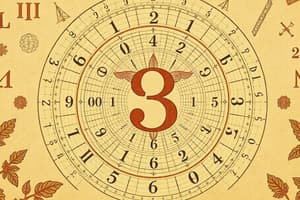Podcast
Questions and Answers
What is the result of the expression $4 + 7 - 3$?
What is the result of the expression $4 + 7 - 3$?
- $8$
- $9$ (correct)
- $10$
- $11$
Which term best describes a mathematical statement that shows two expressions are equal?
Which term best describes a mathematical statement that shows two expressions are equal?
- Function
- Expression
- Equation (correct)
- Variable
What is the sine of $90^ ext{o}$ in trigonometry?
What is the sine of $90^ ext{o}$ in trigonometry?
- 1 (correct)
- 0
- $\frac{1}{2}$
- Undefined
What is the definition of a prime number?
What is the definition of a prime number?
What does the mean of a dataset represent?
What does the mean of a dataset represent?
In calculus, what does the derivative represent?
In calculus, what does the derivative represent?
What is the greatest common divisor (GCD) of $8$ and $12$?
What is the greatest common divisor (GCD) of $8$ and $12$?
What is the unit circle defined as?
What is the unit circle defined as?
Flashcards are hidden until you start studying
Study Notes
Key Concepts in Mathematics
Basic Arithmetic
- Addition (+): Combining two or more numbers to get a sum.
- Subtraction (−): Determining the difference between numbers.
- Multiplication (×): Repeated addition of a number.
- Division (÷): Splitting a number into equal parts.
Algebra
- Variables: Symbols (often x, y) representing unknown values.
- Expressions: Combinations of numbers, variables, and operations (e.g., 2x + 3).
- Equations: Mathematical statements that two expressions are equal (e.g., 2x + 3 = 7).
- Functions: A relation where each input has one output (e.g., f(x) = x^2).
Geometry
- Shapes: Study of properties and relations of points, lines, surfaces, and solids (e.g., triangles, circles).
- Angles: Formed by two rays with a common endpoint, measured in degrees.
- Theorems: Proven statements (e.g., Pythagorean theorem: a² + b² = c² for right triangles).
Trigonometry
- Sine, Cosine, Tangent: Ratios related to the angles and sides of right triangles.
- Unit Circle: A circle with a radius of one centered at the origin of the coordinate plane.
- Identities: Equations involving trigonometric functions that are true for all values (e.g., sin²(x) + cos²(x) = 1).
Calculus
- Limits: The value a function approaches as the input approaches a certain point.
- Derivatives: Measure of how a function changes as its input changes (slope of the tangent).
- Integrals: Measure of the area under a curve, representing accumulation or total value.
Statistics
- Mean: Average of a set of numbers.
- Median: The middle value in a sorted list.
- Mode: The most frequently occurring value in a dataset.
- Standard Deviation: Measure of the amount of variation or dispersion in a set of values.
Probability
- Experiment: An action with uncertain outcomes.
- Event: A specific outcome or set of outcomes of an experiment.
- Probability: The likelihood of an event occurring, ranging from 0 (impossible) to 1 (certain).
Number Theory
- Prime Numbers: Natural numbers greater than 1 that have no positive divisors other than 1 and themselves.
- Divisibility Rules: Guidelines for determining if one integer can be divided by another without a remainder.
- Greatest Common Divisor (GCD): The largest positive integer that divides two or more integers without leaving a remainder.
Mathematical Logic
- Statements: Declarative sentences that are either true or false.
- Logical Connectives: Operations that combine statements (e.g., AND, OR, NOT).
- Quantifiers: Express the extent to which a predicate is true over a range (e.g., "for all", "there exists").
Basic Arithmetic
- Addition combines two or more numbers to obtain a sum.
- Subtraction finds the difference between two numbers.
- Multiplication involves repeated addition of a given number.
- Division splits a number into equal parts.
Algebra
- Variables are symbols like x and y that represent unknown values.
- Expressions are mathematical combinations of numbers, variables, and operations (e.g., 2x + 3).
- Equations state that two expressions are equal (e.g., 2x + 3 = 7).
- Functions represent a relationship where each input corresponds to a single output (e.g., f(x) = x²).
Geometry
- Geometry focuses on the properties and relationships of shapes, such as triangles and circles.
- Angles are formed by two rays that share a common endpoint, measured in degrees.
- Theorems are established truths (e.g., Pythagorean theorem: a² + b² = c² for right triangles).
Trigonometry
- Sine, cosine, and tangent are ratios that relate to the angles and sides in right triangles.
- The unit circle has a radius of one and is centered at the origin in coordinate geometry.
- Trigonometric identities are equations that hold true for all relevant values (e.g., sin²(x) + cos²(x) = 1).
Calculus
- Limits describe the value that a function approaches as the input nears a specific point.
- Derivatives quantify the rate of change of a function, representing the slope of the tangent line.
- Integrals calculate the area beneath a curve, reflecting accumulated total values.
Statistics
- Mean represents the average value of a dataset.
- Median is the middle value when a dataset is ordered.
- Mode identifies the most frequently occurring number in a dataset.
- Standard deviation measures the extent of variation or dispersion within a set of values.
Probability
- An experiment is a procedure with uncertain outcomes.
- An event refers to a specific outcome or collection of outcomes from an experiment.
- Probability quantifies the chance of an event occurring, ranging from 0 (impossible) to 1 (certain).
Number Theory
- Prime numbers are integers greater than 1 that have no divisors other than 1 and themselves.
- Divisibility rules help determine if one integer can divide another without any remainder.
- The greatest common divisor (GCD) is the largest integer that can evenly divide two or more integers.
Mathematical Logic
- Statements are declarative expressions that can be classified as true or false.
- Logical connectives, such as AND, OR, and NOT, unite or modify statements.
- Quantifiers express the degree to which a statement applies over a specified range (e.g., "for all" or "there exists").
Studying That Suits You
Use AI to generate personalized quizzes and flashcards to suit your learning preferences.




